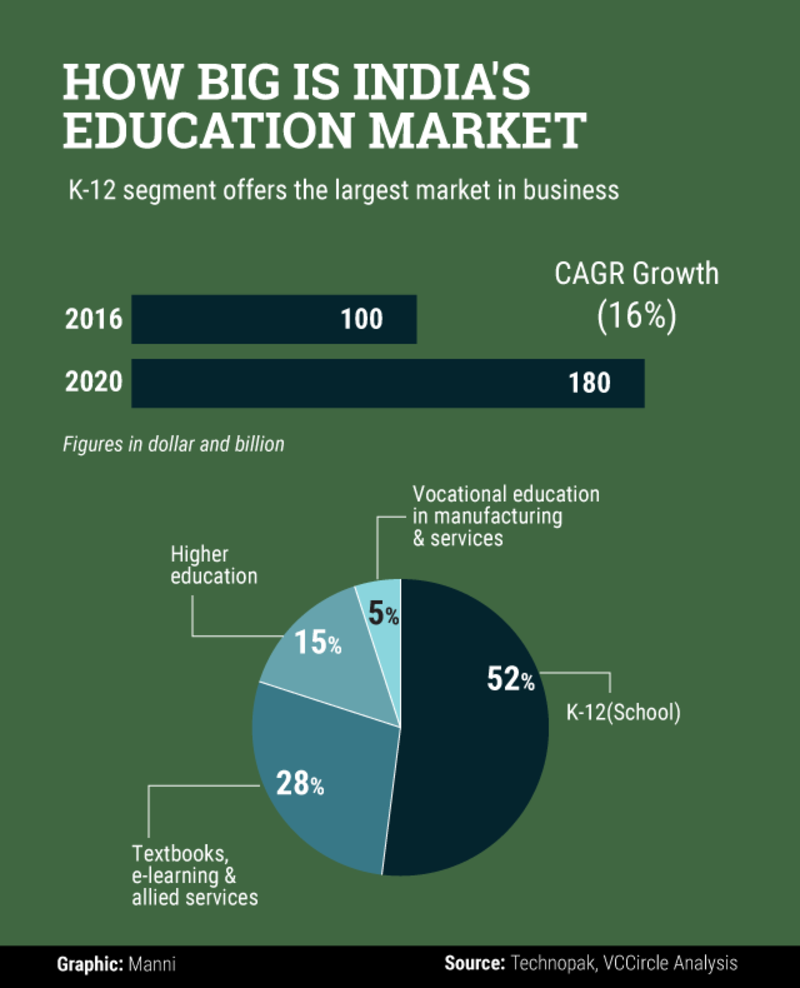Research shows that the Indian education sector, in terms of revenue, stood at $97.8 billion in 2016. FDI in education sector in India: $1.4 billion (April 2000-Dec 2016). India has one of the world’s largest higher education systems with enrollments of 33.3 million students in colleges, institutions, across 50,000+ higher education institutes and 750+ universities.
The School-going population in India provides a huge opportunity.
An increasing number of students are enrolling into schools today to get a formal education; this number is only going to grow exponentially over the years [refer infographic].
The Indian education market is expected to almost double to $180 billion by 2020, buoyed by the rapid expansion of the digital learning market and the world’s largest population in the age bracket of 6 to 17 years in spite of this section being plagued by poor infrastructure and a shortage of trained teachers.
With this data we can establish that there is huge opportunity in the education, however we have to be mindful that traditional methods of teaching will no longer work. As educators we need to keep track of the emerging trends and technological advancements in the education sector, here are some of the major trends to watch out for.
Personalised learning is key.
Each child is unique and they have different interests and learning styles and focusing on them will help hone their talent and make them strong individuals. Hence schools should start shifting their focus towards personalising education for each child.
Integrated learning helps paint the big picture.
Subjects cannot be taught in isolation any more. Schools need to move the focus to integrating subjects. For E.g. While teaching Charlie and the Chocolate Factory in English language children can be taught maths, business etc. Teachers need to get innovative with their teaching methods.
Education should be a two-way street: make it interactive
Teaching young brains is an art, children retain more when learning is fun and stress free. A crucial element in learning is that children should not be told that their way of thinking is wrong, instead encourage them to build on insights in a positive way.
New tech advancements will shape education in the coming years
Virtual Reality immerses the user in a virtual or imaginary environment. Immersive educational environments are already being used to provide learners with a life-like experience in subjects as diverse as history and chemistry. Thus enhancing the virtual learning experience, right from learning Shakespeare or the French revolution in what our classrooms need.
Playing games can be educative
Gamification in Learning is another technological advancement to look out for. Children learn various concepts with the help of games. Instead of traditional rote learning, using video games and incorporating other game elements in education can motivate students to understand better and do well in their exams. As opposed to the traditional classroom learning set up, gamification cuts down boredom and increases their attention span.
Remote proctored assessments are coming.
With the advancements in technology, today remote classrooms and assessments is another space to explore. Students can sit in India and attend a class in a university or school in United States.
Franchising in the education sector can help ensure quality.
Quality education is the need of the hour. We need to take schools far and wide in the country or across borders to increase our literacy levels and Franchising is one alternative to achieve that. Private players are now stepping into this space to multiply opportunities for growth.
Lina Ashar is the founder of Kangaroo Kids Education Ltd.
Read more on education: https://spontaneousorder.in/multipronged-approach-to-education/
Post Disclaimer
The opinions expressed in this essay are those of the authors. They do not purport to reflect the opinions or views of CCS.




